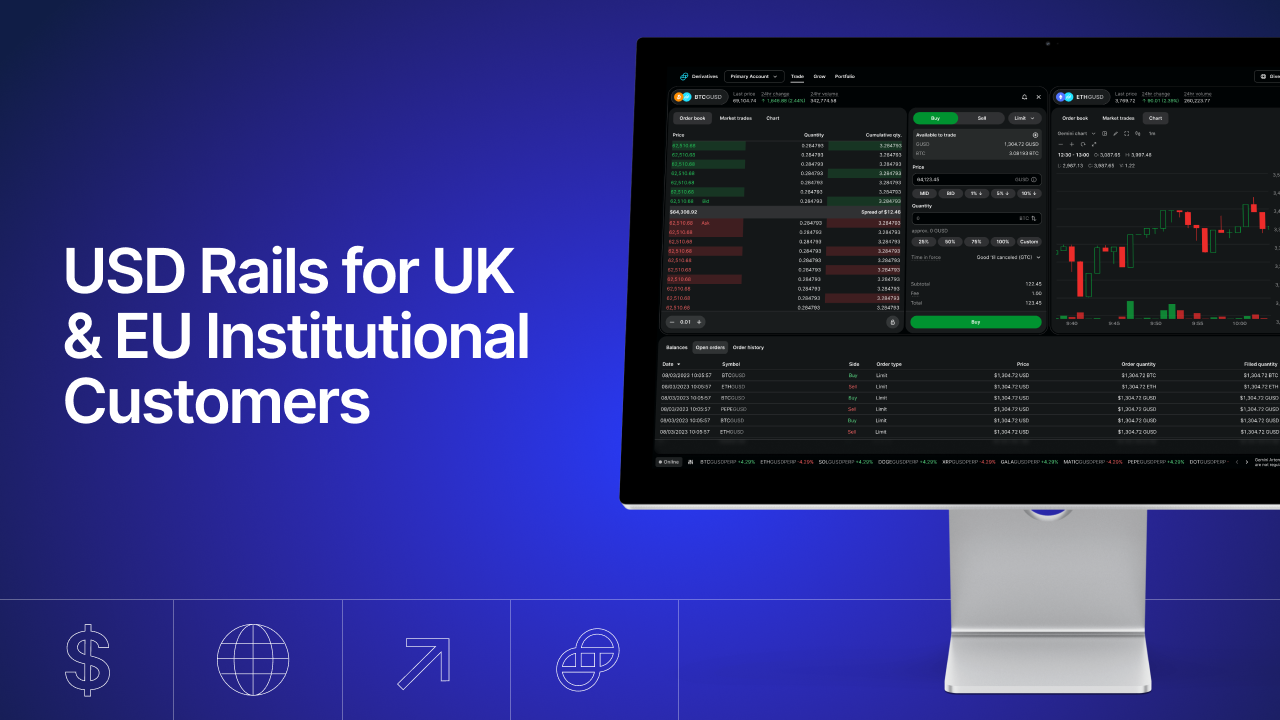Inicio del blog
INDUSTRY
JUN 04, 2023
Gemini Foundation Academy: An Introduction to Perpetual Futures

Welcome to another installment of our Gemini Foundation Academy series. Today, we dig into what perpetual futures are, also known as “perps”. We’ll explore why they’re a popular tool for sophisticated traders, the risks involved, and how traders implement them as part of their trading strategies.
What are Perps, anyway?
Perps, also known as perpetual swaps or perpetual futures contracts, have become quite popular in crypto. To understand why this is the case, we must first understand what a futures contract, or “future”, is.
A future is a derivative instrument whose value is tied to another underlying asset. In crypto, the underlying asset is a cryptocurrency, like bitcoin (BTC). BTC and other cryptos that are bought and sold directly are known as spot. As the value of BTC spot goes up, so does the value of the BTC future. If you buy a BTC future, you profit when BTC goes up. By the same token, if you short sell a BTC future, you profit when BTC goes down.
There are two types of futures contracts: dated and perpetual. Dated futures have an expiration date that, when reached, profits and losses are realized and settled. Perpetual futures contracts, or perps, however, never expire and therefore profits and losses are only realized after closing the position.
Why are Perps so popular?
If the value of a perp is tied to the value of the underlying asset, why not just trade the asset itself? There are several answers to that question, including:
-
The ability to short — In the spot market, your choices are generally to hold the asset or not hold the asset. There isn’t a readily available mechanism to directly bet against an asset. With perps, you can take a short position, effectively betting against an asset, profiting when the price falls.
-
Leverage — With spot, if the price of the asset goes up 10%, the value of your position also goes up 10%. With perps, you can apply leverage, which has a multiplier effect on your gains and losses, sometimes as high as 100x. Leverage allows you to take larger positions with the same amount of capital invested. This capital outlay is known as margin.
-
Lower Cost — Perpetuals tend to be more liquid on exchanges than their spot counterparts, leading to tighter spreads at larger quantities. On many exchanges, trading fees are lower on derivative transactions than on spot as well.
So what are the risks?
While there are advantages to trading perps, it is important to understand the associated risks as well. Here are a couple to be aware of:
-
Leverage — Although leverage magnifies your gains, it also magnifies your losses. When trading perps, it’s important to be cognizant of the amount of leverage you are taking and what the impact of a 5%, 10% or 20% move could mean to your position. You can always adjust your leverage down if you need to be more conservative.
-
Liquidation — Liquidation is the risk that your position will be automatically closed by the exchange due to insufficient margin. This can happen if the market moves against you, causing your position to incur unrealized losses. If your margin account does not have enough capital to satisfy the maintenance margin requirements, your position could be partially, or in some cases, fully liquidated. To avoid this, always keep sufficient capital in your margin account.
How are Perps typically used?
There are multiple reasons why people trade perps. Here, we’ll briefly touch upon a few:
-
Speculation — The most obvious use of perps is to make a directional bet on the price of an asset. Perps allow an investor to specify the direction and size of the position, and with lower capital commitment than with spot.
-
Hedging — If a trader is holding an asset but wants to insulate herself from the risk of the price going down, they can offset their holding by taking a short position in the perp without having to sell the asset outright, which may be undesirable for tax reasons.
-
Trading Strategies — The flexibility and structure of perps makes them ideal for a variety of trading strategies, like basis trading, where the trader can effectively arbitrage price differences between spot, perps, dated futures, or even similar instruments on different exchanges.
Stay tuned for future Gemini Foundation Academy blog posts where we will dive deeper into different aspects of this derivative instrument like margin/leverage, profit/loss, liquidation, and basic trading strategies.
Onward and Upward,
The Gemini Foundation Team
Disclaimer
Cryptocurrency derivatives are complex products that are not suitable for all investors. You should participate in trading crypto derivatives at your own risk and only after doing your own research and understanding the function, terms, and conditions of these products. With leveraged derivatives, you may lose part or all of your investment even if there is only a small fluctuation to the index price.
ARTÍCULOS RELACIONADOS

WEEKLY MARKET UPDATE
MAR 13, 2025
Recession Fears Weigh Down Crypto Market, Mt. Gox Moves ~$1B, and El Salvador Builds Up Bitcoin Reserve

COMPANY
MAR 12, 2025
Gemini To Set Guinness World Record With Largest Bitcoin Drone Show

COMPANY
MAR 12, 2025